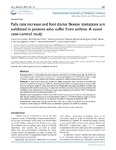Mostrar o rexistro simple do ítem
Falls rate increase and foot dorsal flexion limitations are exhibited in patients who suffer from asthma: A novel case-control study
| dc.contributor.author | López-López, Daniel | |
| dc.contributor.author | Calvo-Lobo, César | |
| dc.contributor.author | Becerro-de-Bengoa-Vallejo, Ricardo | |
| dc.contributor.author | Losa Iglesias, Marta Elena | |
| dc.contributor.author | Painceira-Villar, Roi | |
| dc.contributor.author | García Paz, Vanesa | |
| dc.contributor.author | Munuera-Martínez, Pedro V. | |
| dc.date.accessioned | 2022-03-10T13:10:11Z | |
| dc.date.available | 2022-03-10T13:10:11Z | |
| dc.date.issued | 2019 | |
| dc.identifier.citation | Calvo-Lobo C, Painceira-Villar R, García-Paz V, Becerro-de-Bengoa-Vallejo R, Losa-Iglesias ME, Munuera-Martínez PV, López-López D. Falls rate increase and foot dorsal flexion limitations are exhibited in patients who suffer from asthma: A novel case-control study. Int J Med Sci 2019; 16(4):607-613. doi:10.7150/ijms.32105 | es_ES |
| dc.identifier.issn | 1449-1907 | |
| dc.identifier.uri | http://hdl.handle.net/2183/29953 | |
| dc.description.abstract | [Abstract] Purpose: Based on the possible association between reduced foot dorsiflexion and high risk of falls, the main objective was to determine the ankle and 1º metatarsophalangeal joint (1stMTTP) dorsiflexion range of motion and falls rate in patients with asthma compared to healthy matched-paired controls. Methods: A case-control study was carried out. Eighty participants were recruited and divided into patients with asthma (case group; n=40) and matched-paired healthy participants (control group; n=40). Foot dorsal flexion range of motion (assessed by the Weight-Bearing Lunge Test [WBLT]) and falls rate (evaluated as falls number during the prior year) were considered as the primary outcomes. Indeed, ankle dorsiflexion was measured by a mobile app (º) and a tape measure (cm) as well as 1stMTTP dorsiflexion was determined by and universal goniometer (º). Results: Statistically significant differences (P<.05) showed that patients with asthma presented a greater falls rate than healthy participants and reduced bilateral ankle and 1stMTTP dorsiflexion ranges of motion than healthy participants, except for the left ankle dorsiflexion measured as degrees (P>.05). Conclusions: These study findings showed that a falls rate increase and bilateral foot dorsal flexion limitations of the ankle and 1stMTTP joints are exhibited in patients who suffer from asthma. | es_ES |
| dc.language.iso | eng | es_ES |
| dc.publisher | Ivyspring | es_ES |
| dc.relation.uri | doi:10.7150/ijms.32105 | es_ES |
| dc.rights | Atribución-NoComercial 3.0 España | es_ES |
| dc.rights.uri | http://creativecommons.org/licenses/by-nc/3.0/es/ | * |
| dc.subject | Accidental fall | es_ES |
| dc.subject | Caída accidental | es_ES |
| dc.subject | Ankle joint | es_ES |
| dc.subject | Articulación del tobillo | es_ES |
| dc.subject | Asthma | es_ES |
| dc.subject | Asma | es_ES |
| dc.subject | Hallux | es_ES |
| dc.subject | Range of motion | es_ES |
| dc.subject | Rango de movimiento | es_ES |
| dc.subject | Articular | es_ES |
| dc.subject | Spirometry | es_ES |
| dc.subject | Espirometría | es_ES |
| dc.title | Falls rate increase and foot dorsal flexion limitations are exhibited in patients who suffer from asthma: A novel case-control study | es_ES |
| dc.type | info:eu-repo/semantics/article | es_ES |
| dc.rights.access | info:eu-repo/semantics/openAccess | es_ES |
| UDC.journalTitle | International Journal of Medical Sciences | es_ES |
| UDC.volume | 16 | es_ES |
| UDC.issue | 4 | es_ES |
| UDC.startPage | 607 | es_ES |
| UDC.endPage | 603 | es_ES |
Ficheiros no ítem
Este ítem aparece na(s) seguinte(s) colección(s)
-
GI-UDISAP - Artigos [193]






